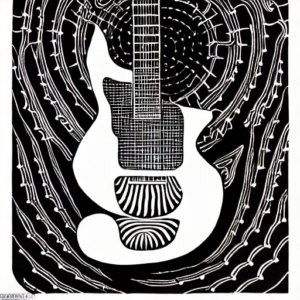The Modes: essential Shred Guitar Theory

My fellow Shredders, there comes a point in any Shred Guitarist’s life when it becomes necessary to start working on some Shred Guitar Theory. There’s been a debate about the value of music theory in the world of Shred guitar that should have been settled long ago. Any information relating to what you’re learning on the guitar is music theory in some way or another, so it’s time to move past that debate.
For Shred Guitar theory, two of the most fundamental areas are scales and modes. But what in the world are modes, you might ask?

The Modes
Well, modes are just scales with a different starting note. For instance, the C major scale is made up of the notes C, D, E, F, G, A, and B. If we start on the second note, D, and play the same sequence of notes, we get the D dorian mode. By starting on different notes and playing the same sequence of notes, we can create seven different modes: ionian, dorian, phrygian, lydian, mixolydian, aeolian, and locrian.
These modes have their own unique sounds and characteristics, and can add some depth and flavor to your solos. Take the phrygian mode, for example. It’s got a dark, exotic sound that can add some tension and suspense to your playing. On the other hand, the lydian mode has a bright, uplifting sound that can add a sense of expansion and openness to your solos.
How modes relate to scales
Modes, of course, are built from scales which, are just the group of notes that are found in a key or in a special context. The most commonly used scale in western music is the major scale, which is made up of seven notes and has a bright, happy sound. This is usually where the modes are derived from. But there are plenty of other scales to explore, such as the minor scale, the pentatonic scale, and the blues scale.
The minor scale is just a mode of the Major scale. Remember when I mentioned the “aeolian mode”? Well that is just a fancy name for the minor scale.
In a very real sense, you can think of the modes as being other scales you can use or change to in order to change the feeling of your solo while staying in the same key.
Using different scales and modes in your solos can help you create a wider range of sounds and emotions. For instance, the minor scale has a melancholy sound that can add some sadness and depth to your playing, while the pentatonic scale has a simple, catchy sound that can make your solos more memorable and hook-like.
The modes are a lot simpler than they sound
If the modes seem way too complicated for you, let me tell you that I felt exactly the same way for years. But what changed that for me was Dan Mumm’s course “The Infinite Shred Method”. This course utilizes Dan Mumm’s unique and powerful method of internalizing the modes across the fretboard. It starts out very simply and slowly builds out a method that simplifies the entire subject based on just a few repeating patters of 3 notes that can be found across the fretboard.
I highly recommend looking into it as building an intuitive comprehension of the modes is an essential part of mastering Shred Guitar. For me, getting the modes down is what opened up the entire fretboard for my solos. It felt like jumping up several skill levels in a very short period of time.
So, to wrap things up, while mastering all of the key shred techniques like alternate picking, legato, sweep picking, economy picking and so on, it’s only in combination with the modes and interesting scales that you can become a skilled and versatile shred guitarist like the Shred Masters. By experimenting with different modes and scales, you can add depth, emotion, and originality to your solos and take your playing to the next level.
Shred on!
